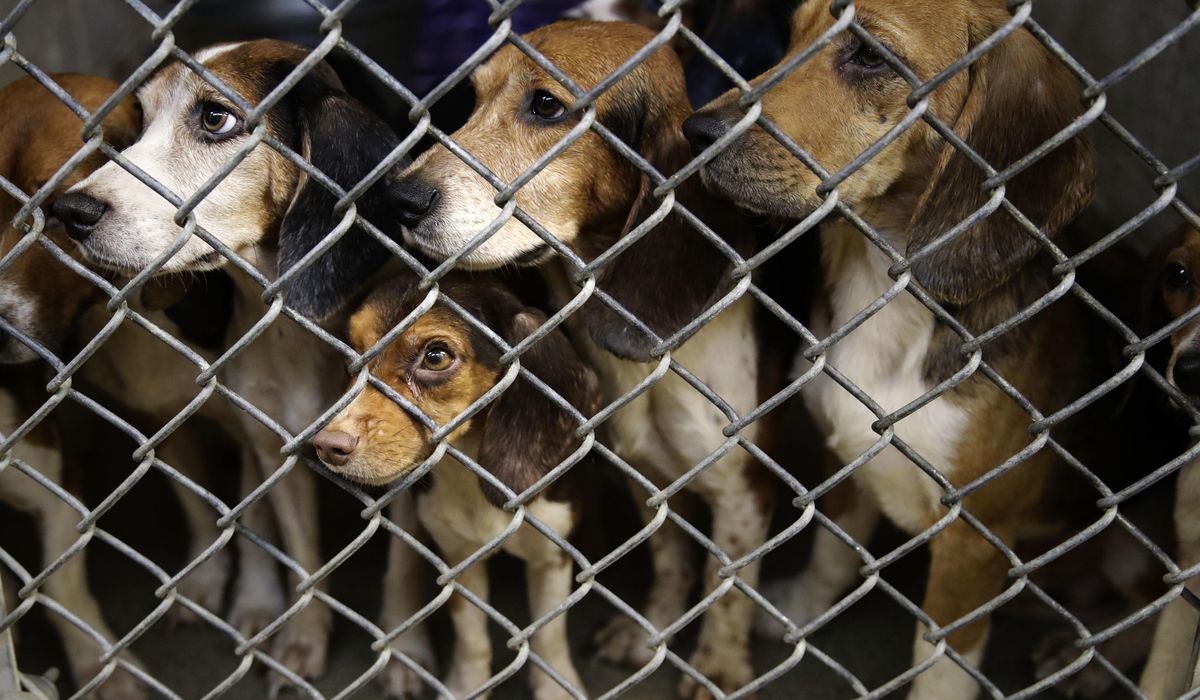
The National Institutes of Health has tested an experimental treatment for cocaine addicts by injecting the drug into beagle puppies.
The “coke hounds” were revealed by the White Coat Waste Project, which discovered details of the $2 million taxpayer-funded experiment lurking in documents disclosed under an open-records request that the group filed.
Six-month-old beagle puppies were outfitted with jackets that injected them with drugs, along with an experimental drug that was fed to them. The dogs were “dosed with cocaine again and again and again for months,” the Waste Project said in its write-up of the experiment.
Researchers filmed the dogs to try to spot any signs of adverse reactions between the drugs. They also operated on the dogs to have a “telemetry unit” implanted to monitor their vital signs.
The dogs were either euthanized or “recycled” for other experiments at the end of the cocaine tests, the Waste Project said.
“Taxpayers should not be forced to foot the multimillion-dollar bill for wasteful and cruel ‘Coke Hound’ experiments in which beagle puppies are injected with cocaine just to fulfill burdensome and outdated FDA red tape,” said Devin Murphy, communications manager at the Waste Project, which works to stop taxpayer-funded research on animals.
The group said the experiment was conducted twice, once from November 2020 to April 2021 and again from May to September last year.
SRI International, a California-based research firm, led the experiment. The company did not respond to multiple requests for comment.
The National Institute on Drug Abuse, part of NIH, which funded the research, said the goal is to find treatments for cocaine disorder.
Although opioids get the most attention, the institute said, nearly 20,000 of the overdose deaths in 2020 involved cocaine. The Food and Drug Administration has not approved any treatment for stimulus disorders, and the experiments are part of an attempt to close that gap.
“Through this particular NIDA contract, researchers performed toxicology studies in a preclinical model to test the safety of a novel drug for the treatment of cocaine use disorder before moving it into a human study. This is done for the sole purpose of ensuring that a new medication will be safe in people who are seeking treatment for cocaine use disorder, and who may resume cocaine use while in treatment,” the institute said.
The folks at the White Coat Waste Project said there are alternatives to using dogs for testing to get FDA approval, but “institutional inertia” means researchers continue to reach for puppies when they don’t have to.
White Coat says most drugs tested on animals are denied approval anyway.
Advocates for animal testing say it’s an important part of the research chain and weed out many drugs, making eventual trials on humans safer.
NIH polices animal testing conducted under its auspices and says it tries to reduce the need to use them.
Applications that propose using animals face a “rigorous review process,” NIDA said.
“Reviewers examine the justification for using animals in each study, whether the research goals can be accomplished using an alternative model, and interventions to minimize pain and distress,” the institute said.
Results of the cocaine-drug interaction are not clear. The documents obtained by the Waste Project say a report may be submitted to NIDA later this year.
Some details of the testing were redacted from the records provided to the Waste Project. Federal officials said it would divulge proprietary information.
Other details were laid out in clinical exactness.
On days they were dosed, the beagles were isolated, forced to fast — but allowed water — and given the cocaine-injection jackets for testing. They were returned to their normal quarters, up to three dogs in the same space, after the jackets were removed.
When not being tested, the animals were given chew toys and “regular opportunity for exercise and socialization” and had regular human contact, the research proposal said.
During one of the tests, each dog was put through nine dosing episodes, six of them involving cocaine injections. The other test had 13 dosings, with six involving cocaine.
Researchers said the experiment was expected to be “non-terminal” — in other words, the dogs were to survive.
Charles River Laboratories, which maintains a “dog colony” for testing and had the equipment for the experiments, could use the beagles for further research or euthanize them with an injection of sodium pentobarbital. The radiotelemetry devices that had been implanted could then be “recovered” from the bodies, the proposal said.
White Coat Waste Project says thousands of dogs are used in taxpayer-funded experiments each year.
Another dog experiment that the group revealed included more than $1 million spent to test the toxicity of drugs — or, as White Coat put it, to “poison” the puppies. The dogs’ vocal cords were cut so they couldn’t bark in the lab, the group said.
That experiment was funded by the National Institute of Allergy and Infectious Disease, run by Dr. Anthony Fauci.








